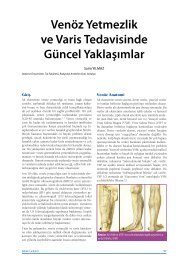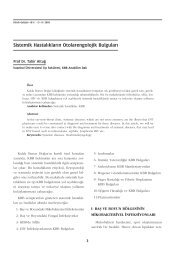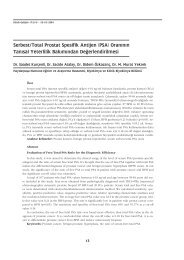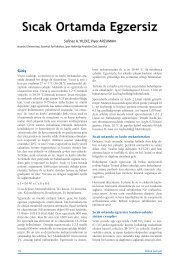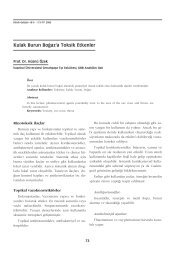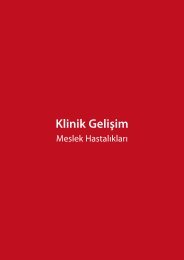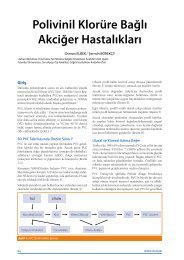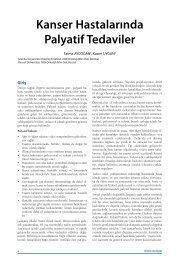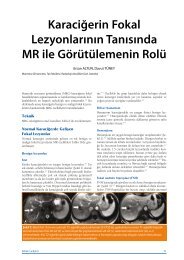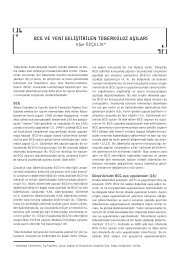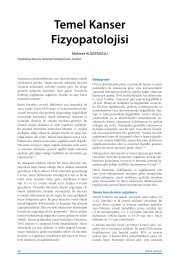Multipl Skleroz Patogenezi ve Yenilikler - Klinik GeliÅim
Multipl Skleroz Patogenezi ve Yenilikler - Klinik GeliÅim
Multipl Skleroz Patogenezi ve Yenilikler - Klinik GeliÅim
You also want an ePaper? Increase the reach of your titles
YUMPU automatically turns print PDFs into web optimized ePapers that Google loves.
özelliğindedir. Lucchinetti <strong>ve</strong> ark. MS lezyonlarının nöropatolojikincelemesinde, demiyelinizasyonun immünopatolojikpaternler bakımından farklılıkları olduğunugöstermişlerdir. 41,42 Bu çalışmada, her bir hastadan izoleedilen aktif lezyonların tümü aynı paterni taşımasınakarşın, hastalar arasında lezyon paternlerinin faklılıkgösterdikleri gözlenmiş <strong>ve</strong> demiyelinizasyon mekanizmalarıdört ayrı paterne ayrılmıştır:Patern 1: Makrofaj bağlantılı demiyelinizasyon olup;akti<strong>ve</strong> makrofajların toksik ürünlerinin (TNF alfa <strong>ve</strong> nitrikoksit) etkisi ile miyelin yıkımının gerçekleştiği EAEmodeline benzer. 43,44Patern 2: Bu paterndeki lezyonlar miyelin oligodendrositglikoproteine (MOG) karşı sensitize edilerek oluşturulanEAE modelinde görülür <strong>ve</strong> miyelin yıkımının olduğubölgelerde immünglobulin <strong>ve</strong> akti<strong>ve</strong> kompleman birikimide olaya eşlik eder. 45Patern 3: Lezyonlar makrofaj, akti<strong>ve</strong> mikroglia <strong>ve</strong> Thücrelerinden oluşan inflamatuvar bir infiltrat içerir <strong>ve</strong>miyelin asosiye glikoproteinin (MAG) belirgin bir kaybıvardır. Bu paternde oligodendrositlerin kaybı <strong>ve</strong> minimalremiyelinizasyon tabloya eşlik eder. MAG kaybı iledistalden proksimale doğru bir oligodendrogliopatiningeliştiği <strong>ve</strong> aksonun gerekli metabolik ihtiyaçlarının karşılanamadığıdüşünülmektedir. 46Patern 4: Nadir görülen <strong>ve</strong> az sayıdaki primer progressifMS’lu hastada tanımlanan bu paternde lezyonlarmakrofaj, akti<strong>ve</strong> mikroglia <strong>ve</strong> T hücrelerinden oluşaninflamatuvar bir infiltrat içermektedir. MAG kaybı,immünglobulin <strong>ve</strong>ya kompleman birikimi ile ilgili birbulgu saptanmaz. Lezyona komşu akmaddede “apoptotikolmayan oligodendrosit ölümü” bulguları gözlenir. Bulgularoligodendrositlerdeki metabolik bir bozukluğun buhücreleri özellikle inflamasyonun toksik hasarına karşıhassaslaştırabileceğini akla getirmektedir. 46Lucchinetti, Lassman <strong>ve</strong> Brück’ün bu çalışmalarındabildirdikleri <strong>ve</strong>rilere karşın, Prineas <strong>ve</strong> arkadaşları; MShastalarının kendilerinde <strong>ve</strong> bireyler arasında lezyonelheterojenite gözlendiğini ileri sürmüşlerdir. Prineas bulgularını,heterojenik bir hastalık etyolojisinden çok, tekbir patofizyolojik mekanizmanın evrimi/gelişimi şeklindeyorumlamaktadır. 47Son yıllarda hızla biriken bilgilerimize rağmen MS; halabilinmeyenlerin çok olduğu kompleks bir hastalık olmaözelliğini sürdürmektedir.Kaynaklar1.2.3.4.Frohman EM, Racke MK, Raine CS. <strong>Multipl</strong>e sclerosis the plaqueand its pathogenesis. N Engl J Med 2006;3 54: 942-955.Bennett JL, Stu O. Update on Inflammation, Neurodegeneration,and Immunoregulation in <strong>Multipl</strong>e Sclerosis: Therapeutic Implications.Clinical Neuropharmacology 2009; 32 (3): 121-130.Ebers GC. Environmental factors and multiple sclerosis. LancetNeurol 2008; 7: 268–277.’t Hart BA, Massacesi L. Clinical, Pathological, and ImmunologicAspects of the <strong>Multipl</strong>e Sclerosis Model in Common Marmosets(Callithrix jacchus). J Neuropathol Exp Neurol 2009; 68 (4):341-355.5.6.7.8.9.10.11.12.13.14.15.16.17.18.19.20.21.22.23.24.25.26.27.Traugott U, Reinherz EL, Raine CS. <strong>Multipl</strong>e sclerosis: distributionof T cell subsets within acti<strong>ve</strong> chronic lesions. Science 1983;219: 308–310.Hauser SL, Bhan AK, Gilles F, et al. Immunohistochemicalanalysis of the cellular infiltrate in multiple sclerosis lesions. AnnNeurol 1986; 19: 578–587.Hohlfeld R, Wekerle H. Immunological update on multiplesclerosis. Curr Opin Neurol 2001; 14: 299–304.Sospedra M, Martin R. Immunology of multiple sclerosis. AnnuRev Immunol 2005; 23: 683–747.Madsen LS, Andersson EC, Jansson L, et al. A humanized modelfor multiple sclerosis using HLA-DR2 and a human T-cell receptor.Nat Genet 1999; 23: 343–347.Friese MA, Fugger L. Pathogenic CD8 T Cells in <strong>Multipl</strong>e Sclerosis.Ann Neurol 2009; 66: 132–141.Pedemonte E, Mancardi G, Giunti D, et al. Mechanism of theadapti<strong>ve</strong> immune response inside the central nervous systemduring inflammatory and autoimmune diseases. Pharmacology &Therapeutics. 2006; 111: 555–566.Springer TA. Traffic signals for lymphocyte recirculation andleukocyte emigration: the multistep paradigm. Cell. 1994; 76:301–314.Charo IF, Ransohoff RM. The many roles of chemokines andchemokine receptors in inflammation. N Engl J Med 2006; 354:610-621.Hemmer B, Cepok S, Zhou D, et al. <strong>Multipl</strong>e sclerosis- a coordinatedimmune attack across the blood brain barrier. Curr NeurovascRes 2004; 1: 141-150.Delgado S, Sheremata WA. The role of CD4+ T-cells in the de<strong>ve</strong>lopmentof MS. Neurol Res 2006; 28: 245-249.Babbe H, Roers A, Waisman A, et al. Clonal expansions of CD8(+)T cells dominate the T cell infiltrate in acti<strong>ve</strong> multiple sclerosis lesionsas shown by micromanipulation and single cell polymerasechain reaction. J Exp Med 2000; 192: 393-404.Crawford MP, Yan SX, Ortega SB et al. High prevalence ofautoreacti<strong>ve</strong>, neuroantigen-specific CD8+ T cells in multiplesclerosis re<strong>ve</strong>aled by no<strong>ve</strong>l flow cytometric assay. Blood 2004;103: 4222-4231.Giuliani F, Goodyer CG, Antel JP, et al. Vulnerability of humanneurons to T cell-mediated cytotoxicity. J Immunol 2003; 171:368-379.Skulina C, Schmidt S, Dornmair K, et al. <strong>Multipl</strong>e sclerosis:brain-infiltrating CD8+ T cells persist as clonal expansions in thecerebrospinal fluid and blood. Proc Natl Acad Sci USA 2004; 101:2428-2433.Dhib-Jalbut S, Gogate N, Jiang H et al. Human microglia activatelymphoproliferati<strong>ve</strong> responses to recall viral antigens. J Neuroimmunol1995; 65: 67-73.Dhib-Jalbut, Kufta CV, Flerlage M et al. Adult human glial cellscan present target antigens to HLA-restricted cytotoxic T-cells. JNeuroimmunol 1990; 29: 203-211.Massa PT, ter Meulen V, Fontana A. Hyperinducibility of Iaantigen on astrocytes correlates with strain-specific susceptibilityto experimental autoimmune encephalomyelitis. Proc Natl AcadSci USA 1987; 84: 4219-4223.Aloisi F, Ria F, Adorini L. Regulation of T cell responses by CNSantigen-presenting cells: different roles for microglia and astrocytes.Immunol Today 2000; 3: 141-147.Hayes GM, Woodroofe MN, Cuzner ML. Microglia are the majorcell type expressing MHC class II in human white matter. J NeurolSci 1987; 80: 25-37.Prat E, Martin R. The immunopathogenesis of multiple sclerosis.J Rehabil Res Dev. 2002; 39 (2): 187-199.Hafler DA, Slavik JM, Anderson DE, et al. <strong>Multipl</strong>e Sclerosis.Immunological Reviews 2005; 204: 208-231.Magliozzi R, Howell O, Vora A et al. Meningeal B-cell folliclesin secondary progressi<strong>ve</strong> multiple sclerosis associate with early<strong>Klinik</strong> Gelişim 63



